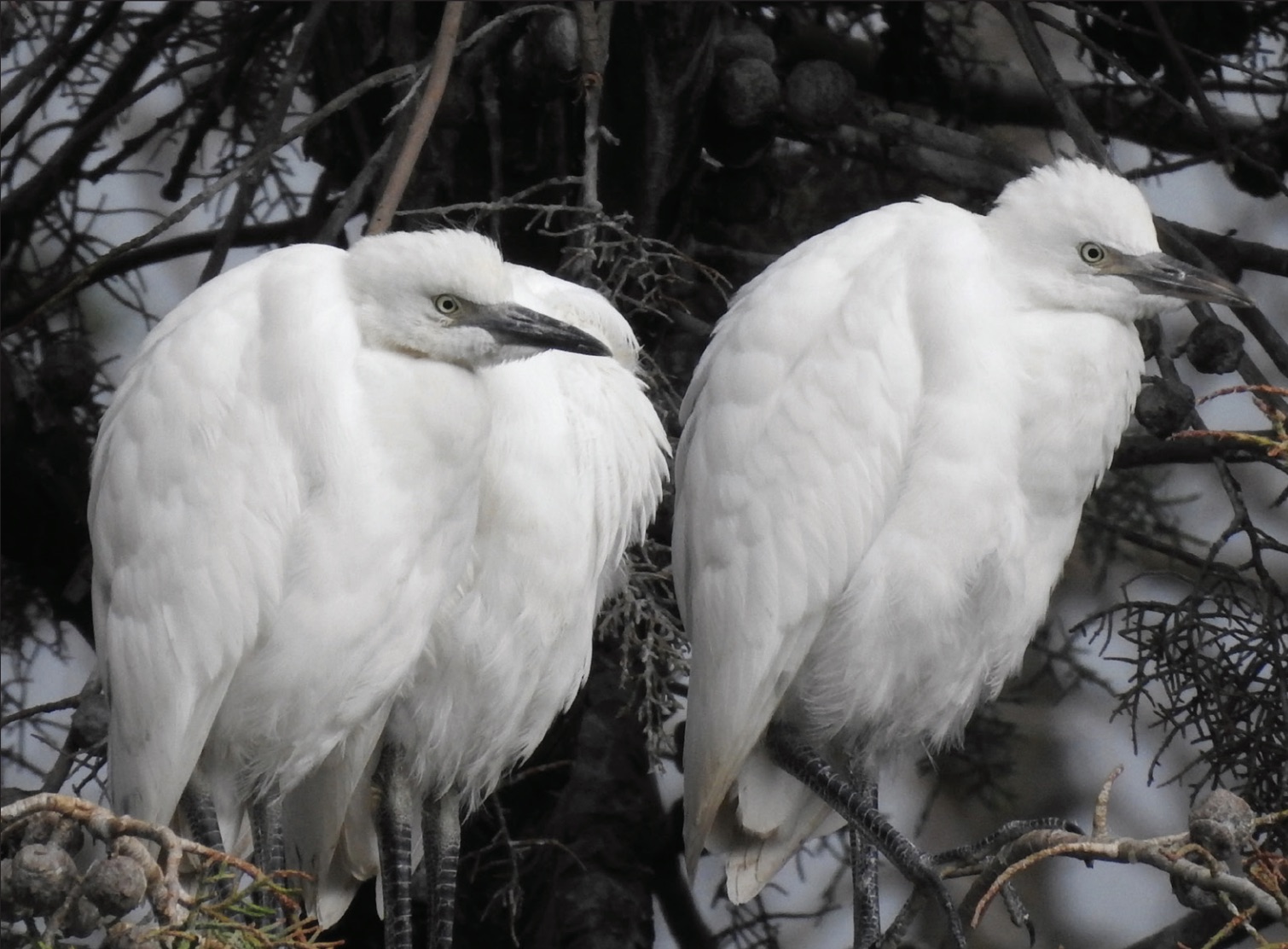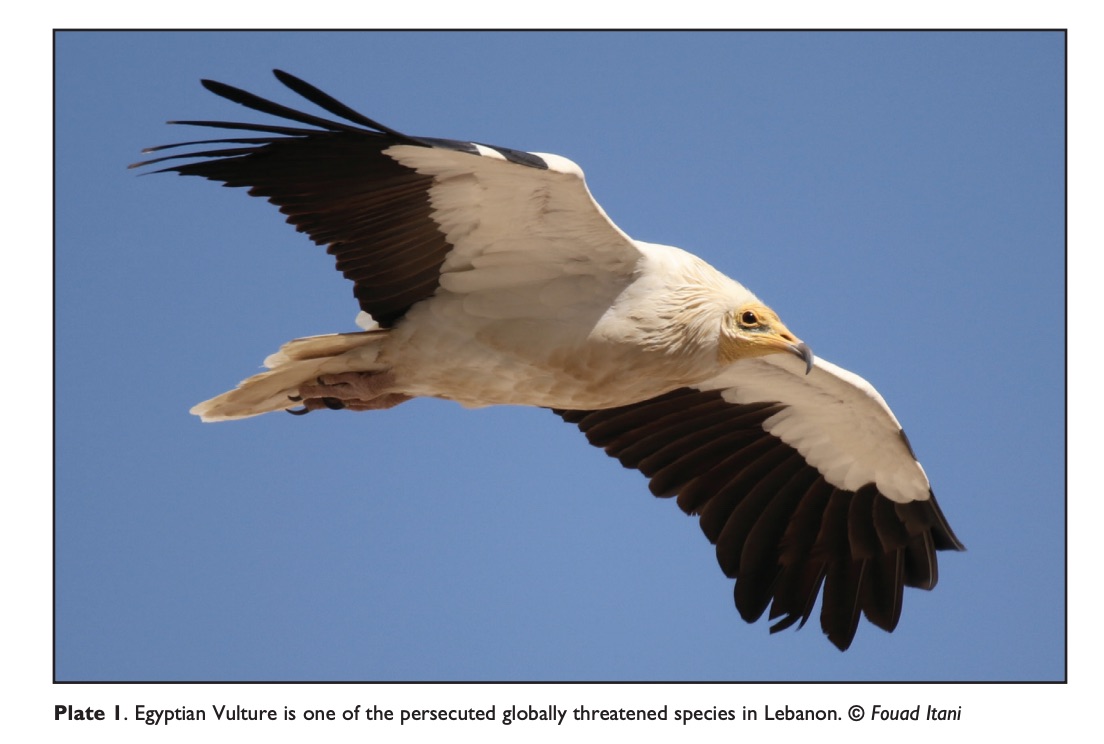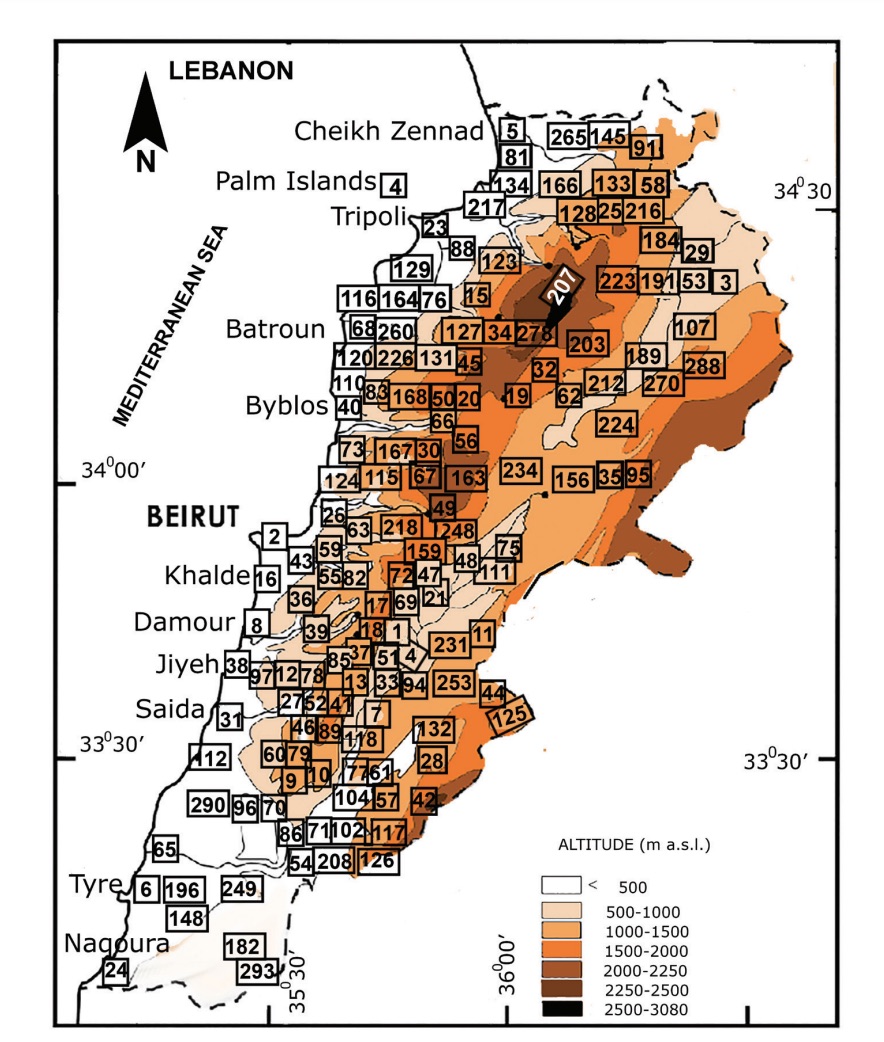
Updated checklist of the birds of Lebanon, with notes on four new breeding species in spring 2020
GHASSAN RAMADAN-JARADI, FOUAD ITANI, JAMES HOGG, ASSAD SERHAL &
MONA RAMADAN-JARADI
Summary: Since the previous published checklist of the birds of Lebanon in 2008, many significant changes to the status and distribution of birds in the country have been recorded. Checklists evolve, and the one presented here uses the standardised taxonomic list for the OSME region. Of the 404 species recorded in Lebanon, nine have been added since the 2008 checklist; 284 (70.3%) are passage migrants or winter visitors (or both); 69 (17.1%) are vagrants; 73 (17.8%) are summer breeders and 65 (16.1%) are breeding residents (some species fall into more than one category). The remaining birds are of uncertain status (Leach’s Storm Petrel Hydrobates leucorhous, Western Brown Fish Owl Bubo (zeylonensis) semenowi, Eurasian Nuthatch Sitta europaea, and White-winged Snowfinch Montifringilla nivalis), have originated from escapes (Red Turtle Dove Streptopelia tranquebarica and Indian Silverbill Lonchura malabarica), were introduced (Mute Swan Cygnus olor, Rock Partridge Alectoris graeca and Common Pheasant Phasianus colchicus), or disappeared from Lebanon for over 120 and 70 years respectively but recently reappeared as vagrants (Lesser Crested Tern Thalasseus bengalensis and Blue-cheeked Bee-eater Merops persicus). We also describe the first breeding records in Lebanon of four species (Squacco Heron Ardeola ralloides, Western Cattle Egret Bubulcus ibis, Little Egret Egretta garzetta and Black-winged Kite Elanus caeruleus) in spring 2020.
INTRODUCTION
This document highlights the most recent changes in the status, distribution and occurrence of all bird species observed in Lebanon. It is based on the previously published checklist of the birds of Lebanon (Ramadan-Jaradi et al 2008), 14 published ornithological papers and two books on the birds of Lebanon between 2008 and 2019, additional published records up to December 2019 (from Around The Region in Sandgrouse), the results of intensive surveys that are conducted on a continual basis in the country and the reports published by the Raptor Count Lebanon supported by OSME, BirdLife International and
SPNL (the BirdLife Partner in Lebanon). In addition, casual observations by an increasing number of birdwatchers and (unfortunately) illegal hunting have provided some important records. Further observation has led to an increase in the number of bird species recorded in Lebanon from 395 in 2009 to 404 in 2019. The nine new species are: Cotton Pygmy Goose Nettapus coromandelianus, White-headed Duck Oxyura leucocephala, Black-eared Kite Milvus (migrans) lineatus, Diederik Cuckoo Chrysococcyx caprius, Eyebrowed Thrush Turdus obscurus, White-crowned Wheatear Oenanthe leucopyga, Eurasian Bullfinch Pyrrhula pyrhula, Common Rosefinch Carpodacus erythrinus, and Red Crossbill Loxia curvirostra. In this paper, we update the information on around 70% of the species listed in Ramadan-Jaradi et al (2008), particularly nine that were proved to breed for the first time in the country (Great Crested Grebe Podiceps cristatus, Squacco Heron Ardeola ralloides, Western Cattle Egret Bubulcus ibis, Little Egret Egretta garzetta, Eurasian Stone-curlew Burhinus oedicnemus, Black winged Kite Elanus caeruleus, Little Ringed Plover Charadrius dubius, European Serin Serinus serinus and European Goldcrest Regulus regulus), five species previously considered to be vagrants that are now known to be regular winter visitors, passage migrants or both (Ruddy Shelduck Tadorna ferruginea, Crested Honey Buzzard Pernis ptilorhynchus, Little Bustard Tetrax tetrax, Armenian Gull Larus armenicus, Black-legged Kittiwake Rissa tridactyla), and three passage migrant species have been found also to regularly winter in the country (Greater Sand Plover Anarhynchus leschenaultii, Ruddy Turnstone Arenaria interpres, Sandwich Tern Thalasseus sandvicensis). Two species previously considered locally extinct have reappeared after 70 years (Blue-cheeked Bee-eater Merops persicus)

and 120 years (Lesser Crested Tern Thalasseus bengalensis). Some breeding species have shown a decline in numbers or occurrence and their status has changed from common to uncommon or scarce (Bonelli’s Eagle Aquila fasciatus, European Turtle Dove Streptopelia
turtur, Sombre Tit Poecile lugubris, Rufous-tailed Scrub Robin Cercotrichas galactotes). The following recorded species in Lebanon are globally threatened: Critically Endangered: Sociable Lapwing Vanellus gregarius; Endangered: White-headed Duck Oxyura leucocephala, Egyptian Vulture Neophron percnopterus (Plate 1), Steppe Eagle Aquila nipalensis, Saker Falcon Falco cherrug; Vulnerable: Marbled Duck Marmaronetta angustirostris, Common Pochard Aythya ferina, Velvet Scoter Melanitta fusca, Yelkouan Shearwater Puffinus yelkouan, Horned Grebe Podiceps auritus, Greater Spotted Eagle Clanga clanga, Eastern Imperial Eagle Aquila heliaca, Great Bustard Otis tarda, Macqueen’s Bustard Chlamydotis macqueenii, Blacklegged Kittiwake Rissa tridactyla, European Turtle Dove Streptopelia turtur, Syrian Serin Serinus syriacus, Rustic Bunting Emberiza rustica.
Finally, for localised species, we list, if appropriate, the main locations where they have been recorded to help guide future assessment, to fill gaps, and provide a basis for followup and monitoring. For all species we provide references for their first occurrence and/or their first breeding record in Lebanon.
SYSTEMATIC LIST
The most significant localities are shown in Figure 1, in which sites with lower serial numbers are those of either of higher ornithological significance (eg Aammiq, Qaa, Cheikh Zennad) or those that are more frequented by observers (eg Beirut, Dalhoun, Ainab). Data on breeding is provided where known. Generally, detailed records are provided only for species with fewer than 10 records and for threatened species where appropriate. Text within square brackets refers to reports that as yet are lacking proof or confirmation or in need of further documentation. They appear here only as hypothetical species, included to encourage observers to submit any outstanding documentation to the Lebanon Bird.

Figure 1. The 145 most significant localities of bird records in the Lebanon, their numbered order reflecting either their ornithological importance or frequency of visits. 1. Aammiq, 2. Beirut, 3. Qaa, 4. Palm Islands, 5. Cheikh Zennad, 6. Tyre Coast, 7. Qaraoun, 8. Damour, 9. Rihane, 10. Jabal Rihane, 11. Anjar, 12. Dalhoun, 13. Arz el Shouf, 14. Litani River, 15. Ehden, 16. Khalde, 17. Ain Zhalta, 18. Barouk, 19. Yammouneh, 20. Aqoura, 21. Tanayel, 23. Tripoli, 24. Naqoura, 25. Qammouha, 26. Nahr el Kalb, 27. Azour, 28. Rachaya, 29. Hermel, 30. Faraya, 31. Saida, 32. Ainata North, 33. Joub Jannine, 34. Bcharre, 35. Baalbek, 36. Ainab, 37. Maasser el Shouf, 38. Jiyeh, 39. Deir el Qamar, 40. Byblos, 41. Niha, 42. Hermon, 43. Baabda, 44. Yanta, 45. Tannourine, 46. Kfarhouneh, 47. Chtaura, 48. Zahleh, 49. Sannine, 50. Laqlouq, 51. Kefraya South, 52. Jezzine, 53. Assi River, 54. Deir Mimas, 55. Aley, 56. Afqa, 57. Chwayya, 58. Bustan, 59. Nahr Beirut, 60. Mlikh, 61. Mimes, 62. Deir el Ahmar, 63. Bikfaya, 64. Alma el Chaab, 65. Qassimyeh, 66. Qartaba, 67. Faqra, 68. Batroun, 69. Qabb Elias, 70. Nabatyeh, 71. Marjayoun, 72. Dahr el Baidar, 73. Bwar, 75. Ryaq, 76. Kousba, 77. Hasbani, 78. Doueir, 79. Aramta, 81. Qleiaat, 82. Bhamdoun, 83. Bentael, 85. Baadaran, 86. Arnoun, 88. Zgharta, 89. Toumat Niha, 91. Qbeiyat, 94. Kamed el Lowz, 95. Jourd Nahleh, 96. Bisri, 97. Maanyeh, 102. Ibl el Saqi, 104. Hasbaya, 107. Fakiha, 110. Amchite, 111. Ablah, 112. Zahrani, 115. Rayfoun, 116. Ras el Chekaa, 117. Rachaya el Fokhar, 118. Machghara, 120. Bejje, 123. Karm el Mohr, 124. Jounieh, 125. Jabal Mazar, 126. Jabal Haouerta, 127. Hadeth el Jibbeh, 128. Fneideq, 129. Enfeh, 131. Douma, 132. Dahr el Ahmar, 133. Chambouq, 134. Bebnine, 144. Tel el Akhdar, 145. Bireh, 148. Qana, 156. Majdaloune, 159. Kneisseh, 163. Kesrouane, 164. Kefraya North, 166. Jebrayel, 167. Hrajel, 168. Ehmej, 182. Ainata South, 184. Zighrine, 189. Wadi Faara, 191. Wadi el Karm, 196. Tair Dibba, 207. Qornet el Saouda, 208. Qlaiaa, 212. Nabha, 216. Mrah el Ain, 217. Minieh, 218. Mtein, 223. Marj Hine, 224. Maqneh, 226. Maifouq, 231. Khiara, 248. Hzarta, 253. Hammara, 260. Eddeh, 265. Deir Janine, 270. Chmis, 278. Bqaa Kafra, 288. Arsal, 290. Insaar, 293. Aitaroun. For information concerning any site, contact the authors.
Rarities Committee (LBRC), which will evaluate these reports on the documentation
available to them; in some cases, this is sparse. The LBRC stress that without full
documentation, acceptance of a report as a record to be added to the Lebanon Checklist
is unlikely.
Key
Abbreviations are used to indicate each species’ status. Lower case abbreviations (eg r, sb, s, wv and pm) indicate that the species is uncommon or rare in the respective season. Resident with definite breeding records
SB Breeding summer visitor
S Non-breeding summer visitor
WV Winter visitor
PM Passage migrant
FB Formerly bred (no breeding records since 1987)
v Vagrant
I Introduced
? Uncertain status
The following abbreviations denote threatened species as per the IUCN Red List categories for 2019: CR: Critically Endangered, EN: Endangered, VU: Vulnerable, NT: Near Threatened. Months are abbreviated eg February = Feb. American University of Beirut is abbreviated to AUB.
CLASSIFICATION ORDER:
The order of species and nomenclature follow the Simplified OSME Region List (Simplified ORL 5.1, Aug 2019), available at www.osme.org, With old records or those lacking sufficient information to assign to species, we have used the parent taxon.
Continue reading via Issuu